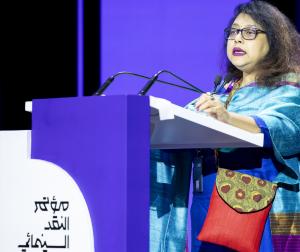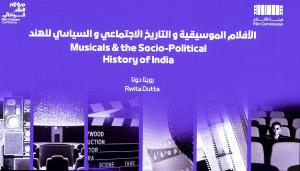The Unmistakable Sound of Indian Musicals Lands A Foothold At The International Film Criticism Conference In Saudi Arabia
RIYADH, SAUDI ARABIA, November 18, 2024 /EINPresswire.com/ -- Bollywood musical films have added a thrilling touch to the International Film Criticism Conference in Riyadh, organized by the Saudi Film Commission from 6th to 10th of November.
Bollywood films were evident with all their distinctive elements; their songs, melodies, and all the sounds that evoke the timeless nostalgia in the hearts if viewers.
During “Beyond Criticism” segment, Indian film critic Rita Dutta gave a presentation titled “How Bollywood Musical Films Represented the Changing Dynamics of Indian Society,” Where she explored the dynamic relationship between Bollywood films and the changes in India, and the ongoing lively correlation between Bollywood musicals and the cultural, social and even political fabric of Indian society.
Film critic Dutta traced the history of Bollywood musical films back to the 1950s, extending it to the modern day - to confirm that the sound in Bollywood films is the voice of India, developing with it, living its transformations, and contributing to it. Throughout its long history, Bollywood musicals have been a cultural mirror reflecting the changing social dynamics, values, and aspirations of Indian society, from early Bollywood films that explored themes of patriotism and social harmony to modern-day music that explores themes of independence, love, and ambition.
Dutta mentioned that Bollywood musicals have provided a unique window into India's evolving identity, as cinema was able to adapt to shifts in the social, political and economic landscape, bringing new narratives and diverse voices to the screen.
Dutta also confirmed that each era of Bollywood films was not limited only to entertainment, but also served as a sound to the societal changes that were taking place around them. Bollywood films responded to major cultural shifts in India, capturing the country’s collective consciousness in melodies and lyrics that continue to resonate with audiences across generations.
Dutta showed cinematic scenes from films from different eras to enrich the analytical presentation.
Dutta began her presentation by emphasizing that the quintessential conventions of commercial Bollywood films were established with the emergence of the Masala film genre, which combines elements of multiple genres (action, comedy, romance, drama, melodrama, musical).
Dutta added that the song and dance sequence in Bollywood films also used as a narrative device in films of every genre from comedies and romances to crime thrillers and horror films, most of which, routinely, may have five or more songs. The lyrics of songs are used to convey progressions in sequence and character moods much more succinctly than volumes of dialogues and visual sequences, accompanied by vocal music backed by an appropriate orchestral tenor in both popular and art-house Hindi films. In one word, the history of Hindi cinema is in many ways the history of song and dance.
Dutta pointed out that, with over 70 major languages, four major religions, and numerous different cultures, keeping the country and its people united is no easy task. Urdu/Hindi movies produced in Mumbai, especially the ones during the pre-independence period to the 1950s; relied on a language that was understood in all parts of India. Mumbai cinema, the stars of these cinemas, and the music popularized by these films were seen as the “Indian Cinema”, Indian stars, and Indian film music. In this regard, the Mumbai film industry served as ties that bonded diverse nations within in India.
Dutta also stated: The ways in which these elements have shifted over the ensuing decades, reflecting at times the serendipitous method not only of incorporating these elements into the film story but also, more broadly, of the development of the cinema itself as a storytelling device. In the same time, music and performance have continued to play a critical role not only in the world of the Indian film, but in international cinema as well.
Dutta also spoke on Hollywood, where many genres and genres of stories were developed, such as mafia films, westerns, family dramas, historical films, fashion films, romance, war drama, and musicals. She pointed out that Indian cinema copied all these genres, but with two clear differences, irrespective of their story-types; a majority of the Indian films included a love story, and almost all of them contained musical scores and dances. The tradition of song and dance in the Indian cinema has come from the Indian theatre that had its roots in fantasy and mythology.
Dutta stated that she believes that the most significant films of the 90s that brought about a major change were: Dil to Pagal Hai (directed by: Yash Chopra/1997), Kuch Kuch Hota Hai (directed by: Karan Johar, 1998), and Dil Chahta Hai (directed by: Farhan Akhtar/2001).
The Film Criticism Conference also featured a screening of the 1957 film Pyaasa, followed by a critical discussion session with Indian film critic VK Joseph. The film depicts a social saga that surrounded India, telling the story of a writer and poet struggling to achieve success and get the recognition he deserves for his works that address the disturbing social phenomena of that era. VK Joseph spoke about the film’s role in highlighting people’s concerns at that critical time, in addition to the film’s exceptional soundtrack, which was collaborated by some of India’s greatest composers to create a masterpiece that deepens the role of sound in film.
The screenings and panel sessions were parts of the International Film Criticism Conference’s agenda, which was held by the Saudi Film Commission under the title “Sound in Cinema.” The conference is held annually to bring together specialists and cinephiles to exchange expertise and ideas in addition to enhancing national, regional and international empowerment of film criticism, a crucial element to the development of the film industry.
--------------
--------------
email us here
Legal Disclaimer:
EIN Presswire provides this news content "as is" without warranty of any kind. We do not accept any responsibility or liability for the accuracy, content, images, videos, licenses, completeness, legality, or reliability of the information contained in this article. If you have any complaints or copyright issues related to this article, kindly contact the author above.




